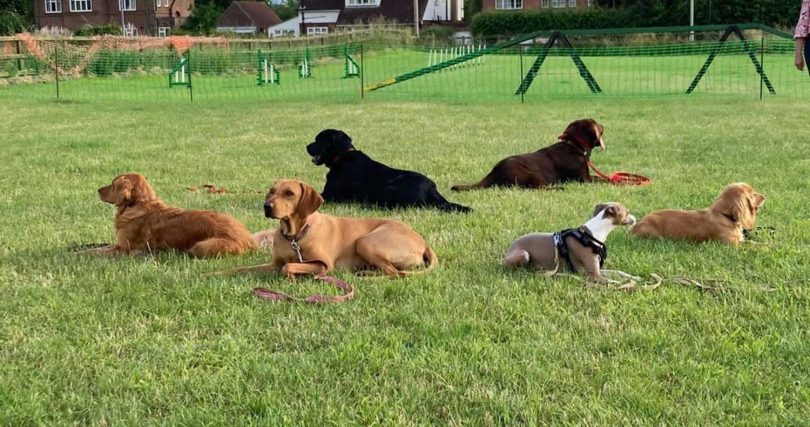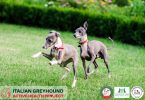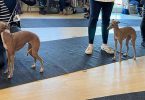It would not be possible to write an article explaining how to train an Italian Greyhound, but I can share with you what I have learned and what has worked wonders for me with the Italian Greyhounds in my life.
How difficult is it to train an Italian Greyhound?
Training an Italian Greyhound is a hot-topic of Italian Greyhound related social media forums, with owners and potential owners frequently discussing the matter. With a mixed bag of results in the replies to this topic, it really does lead to the question of what any one individual means by “training”, what approach they have taken, and how persistently they have tried. There are too many variables to be able to draw a firm conclusion as to how difficult it is to train an Italian Greyhound. In my experience, they are perfectly trainable, albeit skittish with a short attention span. However, this isn’t unsurmountable and can, in some instances, be turned to an advantage.
The basics of Dog Training
There are 3 types of dog training/dog trainers:
- Type 1 – Aversive training
This trainer tells the dog off when the dog doesn’t do the desired thing/give the required response. They also use aversive tools and methods such as choke chains, corrector sprays, anti-bark collars, and shock collars to quickly achieve their desired results. - Type 2 – Balanced training
This trainer uses positive reinforcement, such as praise, toys and edible treats, combined with aversive methods. - Type 3 – Concept training
This trainer uses a completely different approach altogether, by using games and play to “re-shape” the dog’s brain and thought pattern into choosing to give the desired results.
I am a Type 3 trainer and I have trained my Italian Greyhounds using Concept Training. Initially, I trained with a Dog Trainer who’s profession is to train Assistance Dogs. I figured that, if you’re capable of training a dog to happily empty a washing machine, you know what you’re doing when it comes to training a domestic pet dog to sit, come, stay, wait. I found Concept Training so fascinating, I went on to gain qualifications myself.
What is Concept Training?
Concept training uses games to tap into the domestic dog’s innate natural instincts and turn them to our advantage by “reshaping” the dog’s thought pattern and subsequent behaviour. This is much simpler than it sounds!
- Tugging Games = emptying a washing machine, helping with removing clothes, opening a door.
- Retrieving = picking up a dropped bottle top, taking a bank card out of a payment terminal, fetching an item of clothing.
- Pushing with their nose = pushing the button at a pelican crossing, or pressing a door bell.
Okay, so training an Italian Greyhound to do these things might not be your ambition, but the principles are the same, regardless! You can reshape a dogs brain to enjoy doing what you want and need them to do, regardless of the breed.
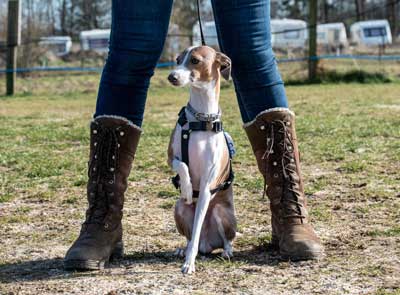
What are the benefits of Concept Training?
Achieve loose-lead walking, good recall, calmness while you work, or entertain friends, solid boundaries when you take your Iggy with you to the pub, or out for a meal, have your Iggy choose their bed or blanket over beds and sofas when visiting friends or staying away. If you can train and Assistance Dog, you can train a domestic pet dog! You can even inspire fussy eaters to eat their food!
Other benefits of Concept Training include:
- It does not involve aversive or dominant handling or management
- It is not fear-based, in any way
- It taps into the dog’s innate behaviours and thought processes
- It’s easy to understand and quick to apply
- You train for the situation, not in the situation
- The dogs enjoy it
- You get real-life results, because the dog enjoys it
- It’s easy to fit into your every day life
- It’s relationship building between you and your dog
- A longer training session makes for an excellent alternative to walking in bad weather, periods of recovery from injury and illness, and it tires out puppies and young dogs VERY quickly!
Concept Training delivers such excellent results, it is an increasingly popular approach for most activities and needs:
- Assistance Dogs
- Medical Alert Dogs
- Police Dogs
- Sniffer Dogs
- Search and Rescue Dogs
- Agility competitors
- Gun Dogs
- Domestic Dogs
How long does it take to train an Italian Greyhound?
The truthful answer is that dog training never ends. That’s not to say that you are signing up to a lifetime of military-style drilling for the rest of your Italian Greyhound’s life. It really is much, much simpler than that.
How much time do I need to spend training every day?
A few minutes, 2-3 times a day. Concept Training involves training via games, so all you need is your selection of games to play and to make time to play them.
You can also look for opportunities to incorporate training games into your daily routine, for example:
- Train recall when serving your dog’s meal – recall or whistle your dog when you put down their food bowl.
- Have your dog sit-wait when you go through a doorway from one room to another.
- Instil value in close proximity, as well as recall by using treats (dehydrated meat, sprats etc) to play “find it” games.
- Use your work time (if you work from home) and/or meal times to encourage calmness, boundaries, and self-sufficiency.
Once these daily occurrences are teamed with a constructive game, training your Italian Greyhound becomes second-nature.
Building Blocks
Once your Italian Greyhound has mastered one game, it is easier for them to learn another two. Once they have mastered three games, they will master another five in no time. You don’t need to tackle the games one at a time, just that the more your Italian Greyhound achieves, the more quickly they will master new games going forward. Eventually, you will see your dog pre-empting what you want him or her to do and your life with them will be a lot more harmonious as a result!
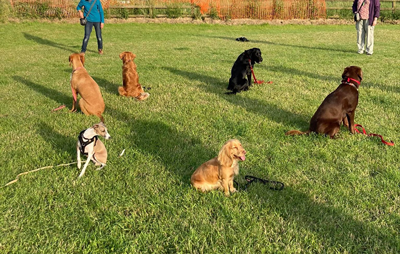
What do I need to successfully train an Italian Greyhound?
Firstly, you need to shake off any idea that it is impossible to train an Italian Greyhound. Iggies are no more difficult to train than any other dog! In every breed you get individual dogs that are very receptive to training and others that are not. Very often, the dogs who seem the most impossible are the ones with the most active minds which are ripe for “reshaping” and structuring, and they often go on to do very well at learning more complex games and tasks.
Secondly, you need to be disciplined yourself in reaching your dog training goals. Throughout my dog training journey I have seen owners of all breeds of dog satisfied that they have trained their dog themselves without following any program. More often than not, their dog isn’t trained at all; the dog is simply conditioned to fit in with their lifestyle, usually through persistently shouting and scolding unwanted behaviour so the dog simply learns to avoid this. All dogs think and make choices as to how they behave; you want them to make the right choices, not simply avoid a scolding.
Structured Games-Based Training
Obviously, you will need your training games. A professional Dog Trainer doesn’t train your dog for you, they train you to train your own dog in every day life, and there are many options for learning nowadays, both in person and online.
If looking for a trainer or dog school you can attend, you will need to ensure your choice is not a Type 1 Aversive Trainer. For effective games-based training you will need a Type 3 Concept Trainer. Dog training is unregulated in the UK, so anyone can set themselves up as a trainer, with or without qualifications. Unfortunately, because people tend to want quick fixes for dog training, trainers using unorthodox or aversive methods often get good reviews from such owners, giving a false impression of the quality of the Dog Trainer.
If you would prefer to train at home, there are online resources available. Dogs That, by Susan Garret and the Say Yes Dog Training Team, is an online dog school offering fun, easy to follow online video tutorials for training your dog, as well as an insightful podcast discussing common behaviour and training issues. Susan Garret is one of the most successful dog trainers and agility competitors of the last three decade. She has also earned a Bachelor of Science majoring in Animal Science, and she endorses innovative game-based positive reinforcement training that is grounded in the science of animal behaviour. It is quite possible to fully train your Italian Greyhound using an online resource like this.
Commitment
Achieving your dog training goals will not happen over night. You cannot play a game a handful of times over a few weeks and declare it a failure. You will need to find a few minutes to play your selection of games every day. As time passes and your Italian Greyhound becomes accomplished, you will find that the training becomes less intense and more part of your every day interactions with your dog. Because the dogs enjoy games-based training, you will eventually not even notice it becoming part of your daily life.

Consistency
Choose your commands wisely. Your dog does not understand what the words mean, so it doesn’t matter what word you associate with a particular action. As discussed in our article How to choose your dog’s name, a command that sounds similar to your dog’s name can cause confusion. For example, if your dog is named Sid, you may not want to use “sit” as a command. You could use any other word in it’s place, as long as you are consistent with it, so the dog quickly associates the word with the desired action/response.
You have to be consistent with training in general. If you address/re-shape a dog’s behaviour one time but not the next, you are sending mixed messages to your dog which will hinder progress. You absolutely must be consistent in your approach, using the same words and commands, and responding to certain behaviours every day.
“High Value” and “Low Value” treats
Concept Training does not rely heavily on using treats, it tends to be Type 2 Balanced Trainers that heavily rely on treats as positive vs negative reinforcement. Concept Trainers use treats, toys, and verbal praise; to establish verbal commands and meanings, mark when a dog has made the right decision or completed the desired action, and to make the training rewarding for the dog. Treats are not used for bribery, Low value treats are your foundation for placing value in where you want your dog to be and building the duration of choosing to stay there. High value treats mark the big decisions your Iggy makes, like an immediate recall at the park, or going to their bed (boundary) when you sit down to eat.
Dogs tend to fall into two categories when it comes to training with treats:
- Freeloaders – dogs that are food-orientated and enjoy being given lots of treats
- Contra-freeloaders – dogs that prefer to “work” for their food, rather than simply be given it (often interpreted as fussy eaters)
Both types of dogs have their advantages and disadvantages when it comes to training, but because Concept Training doesn’t rely heavily or solely on treats, either type of dog is receptive to training.
Treats are something you can slowly withdraw over time, and you will have a well-behaved dog without having to keep stinky treats to hand everywhere you go! Because you have reshaped your Iggy’s thought process and choices rather than bribed/shouted at them until they behave, your dog will happily work with you and simply enjoy the relationship with you.
Multi-Dog Households
Training can be difficult in multi dog households, but spending just 3 minutes a day with individual dogs will gradually produce progress and results. Eventually, you will be able to train two or more dogs together while they take turns to work with you.
Conclusion
Effective dog training has never before been so accessible as it is today in the digital age, with options to learn via video tutorial, and games-based training is easy to follow and apply. Combine this with resolve, commitment, and consistency and you can at least improve your Italian Greyhound’s behaviour, helping to keep them safe, and your lives together harmonious.


